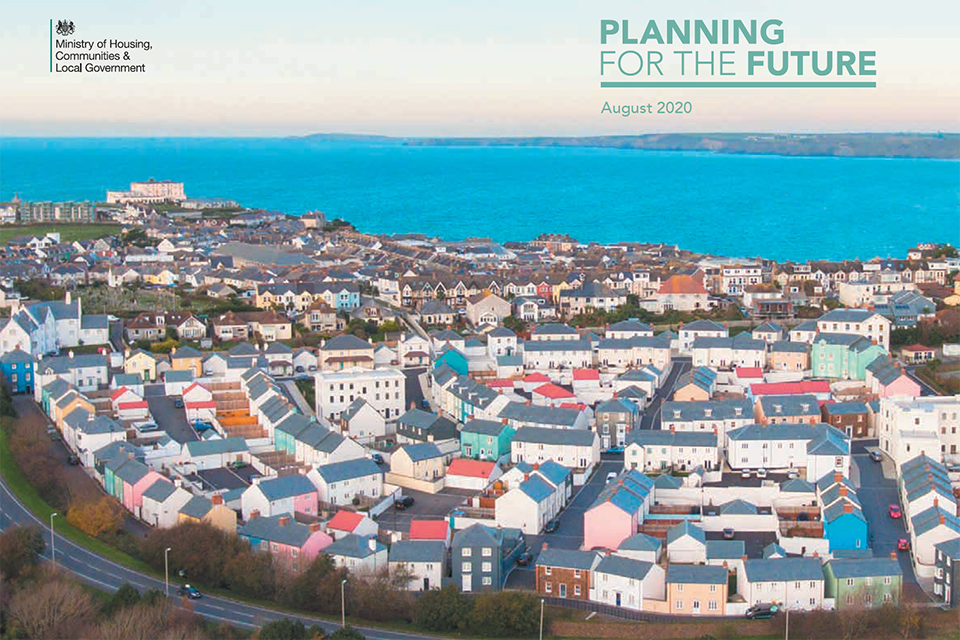Sectors - Civil
Consultation Launched to Reform Planning
7 Aug 20

The UK Government has announced a major overhaul of the country’s outdated planning system so that it can deliver the high-quality, sustainable housing communities need.
The Housing Secretary, Robert Jenrick, announced the landmark changes on 6 August 2020. The changes will transform a system that has been criticised for being too sluggish when providing housing for families, key workers, and young people and too ineffectual in obliging developers to properly fund the infrastructure to support them, such as schools, roads and GP surgeries.
Value green spaces and Green Belt will continue to be protected for future generation with the new reforms allowing more building to be done on brownfield land. Local community agreements will also be at the heart of the proposals being put forward in the new Planning for the Future whitepaper which was also published on Thursday 6 August 2020.
The new changes will be a massive boost for SME builders who are currently cut off by the outdated planning system. They will now become key players in getting the UK building on the scale needed to drive further economic economy, while leading homebuilding that is beautiful and also builds on local heritage and character.
Recent studies have also shown that smaller firms feel the complexities of the planning process and is associated risks, delays and costs are the main challenges they face when it comes to homebuilding.
Housing Secretary Rt Hon Robert Jenrick MP said: “Our complex planning system has been a barrier to building the homes people need; it takes 7 years to agree local housing plans and 5 years just to get a spade in the ground.
“These once in a generation reforms will lay the foundations for a brighter future, providing more homes for young people and creating better quality neighbourhoods and homes across the country. We will cut red tape, but not standards, placing a higher regard on quality, design and the environment than ever before. Planning decisions will be simple and transparent, with local democracy at the heart of the process.
As we face the economic effects of the pandemic, now is the time for decisive action and a clear plan for jobs and growth. Our reforms will create thousands of jobs, lessen the dominance of big builders in the system, providing a major boost for small building companies across the country.”
Heather Lindley-Clapp, Associate Director at Nexus Planning’s Manchester office said: “We welcome the government’s drive to front-load the planning process through the update to both national policy guidance and the introduction of local design guides across the board, and supporting schemes which comply with local guidance.
“There will be a greater desire to ensure development is well-designed and in-keeping with local circumstances and will fast-track those developments which comply with the guidance. In this regard however, it will be important for local authorities to seek to produce local guidance and local authorities will have additional pressures to produce detailed local design guidance which will require input from experts across the field. Using ‘best practice’ guidance will assist local authorities, but this will likely be a relatively costly and lengthy process.”
Responding to the Planning for the Future White Paper Richard Brown, Deputy Director at Centre for London said: “The government’s proposals are radical and far-reaching. They offer potential – for more meaningful community engagement, higher design standards, a less costly and risky planning system, and more clarity for smaller builders and developers.
“However, implementation will be complex, and a reformed planning system will need to be backed up by other incentives to accelerate house building. London already has a ‘pipeline’ of 280,000 homes that have planning permission but have not been built.
“And the White Paper is silent on London, the role of the Mayor and the London Plan, and the role of other metro mayors and combined authorities. The complexities of England’s cities call for intelligent and engaged regional, as well as local planning.”
The reforms will mean:
- Local communities will be consulted form the very beginning of the planning process. By harnessing the latest technology through online maps and data, the whole system will be made more accessible
- Valued green spaces will be protected for future generation by allowing for more building on brownfield land and all new streets to be tree lined
- Much-needed homes will be built quicker by ensuring local housing plans are developed and agreed in 30 months, down from the current seven years
- Every area will have a local plan in place – currently on 50% of local area have a plan to build more homes
- The planning process to be overhauled and replaced by a clearer, rules-based system. Currently around a third of planning cases that go to appeal are overturned at appeal
- A new simpler national levy to replace the current system of developer contributions which often causes delay
- The creation of a fast-track system for beautiful buildings and establishing local design guidance for developers to build and preserve beautiful communities
- All new homes to be ‘zero carbon ready’, with no new homes delivered under the new system needed to retrofitted as we achieve our commitment to net zero carbon emissions by 2050.
The Housing Secretary also confirmed that the First Home schemes is provide newly-built homes at a 30% discount for local people, key workers and first-time buyes. This discount will be locked into the home in perpetuity, ensuring future buyers can continue to benefit from it.
A new and simple system will also ensure that private firms play their part in funding new infrastructure and affordable home that should accompany new building. Section 106 agreements and the Community Infrastructure Levy will be replaced with a new Infrastructure Levy which will be a fixed proportion of the value of the development, above a set threshold helping to deliver more affordable housing.
Revenues would be spent locally on projects such as new roads, upgraded playgrounds and discounted homes for local, first-time buyers.
Towns and high streets will benefit from renewed development too, with the reforms speeding up and simplifying the process, breathing new life into vacant commercial property and industrial spaces, and where desirable, transforming them into new houses.
At their heart, these new proposals will ensure councils priorities good design, establish strong, local guidance and create a fast-track for approving beautiful buildings.
Decisions on the Green Belt will stay with local authorities as they prepare their plans, so that we can continue to protect and enhance these important areas for generations to come.
Following the publication of Planning for the future, the government will now consult with planners, lawyers and local government experts on the proposals, as well as interest groups and residents.
If you would like to read more like this, then please click here
Related Articles
- Construction Reforms Must Be Accelerated
5 Nov 21
Government and industry must work together to spur an improvement in construction buying habits if
- Sky is the Limit for Createmaster
3 Nov 21
Createmaster has won the contract to provide all handover information for Sky Studios Elstree, in
- On-Site Sustainability & Innovation Hub Revealed
2 Nov 21
Following on from the launch of the on-site Training Centre at Mercia Park, Winvic Construction
-
-
Latest News
- Landfill tax will not enable the circular economy
11 Dec 25
The National Federation of Builders (NFB) has released a short report titled, ‘Going full circle:
- Belfast Harbour Secured as £100 Million Hub for Major Offshore Wind Projects
10 Dec 25
Belfast Harbour is set to become the primary assembly and construction hub for two of
- Government Earmarks Rail-Adjacent Land for Accelerated Housing Development
9 Dec 25
The UK government has announced a significant package of planning reforms designed to accelerate the
- Environmental goals prioritised as land for next phase of new town prepared for development
5 Dec 25
Northstowe is a sustainable new town comprising homes, education and community space.
- New laws will strengthen cyber defences for essential public services
4 Dec 25
UK government has introduced the Cyber Security and Resilience Bill to Parliament.
- Jacobs to deliver advisory services to public sector clients through 2027
3 Dec 25
Jacobs has been named as a supplier on the Crown Commercial Service’s (CCS) Management Consultancy
-
-





